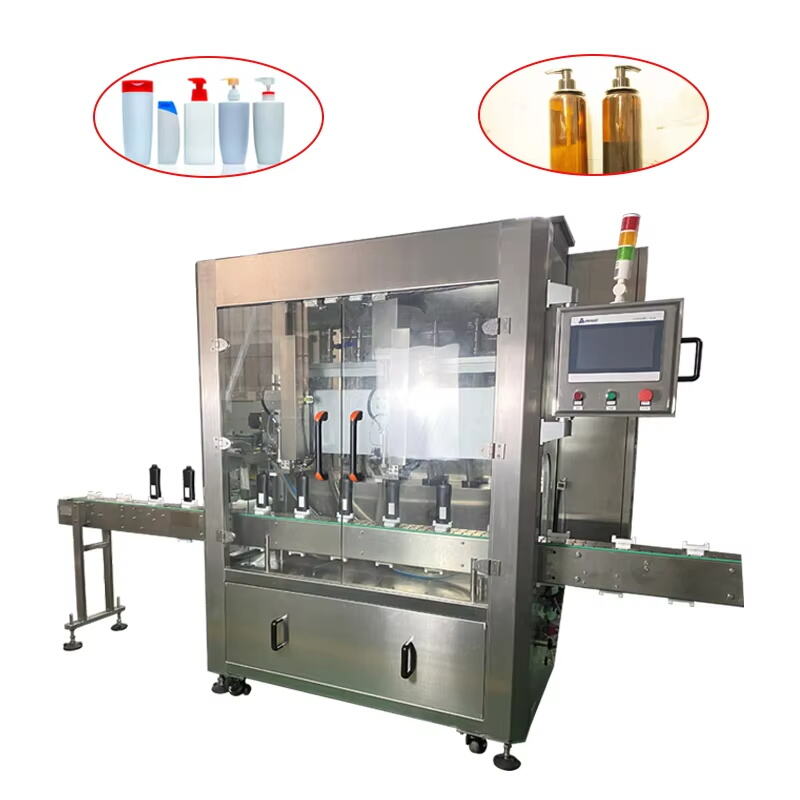วิธีที่อัตโนมัติช่วยลดแรงงานในกระบวนการบรรจุภัณฑ์
กำจัดงานด้วยมือผ่านการบูรณาการเครื่องจักรสำหรับการแพ็ค
Wolf Working Machines ได้แนะนำการผนวกรวมเครื่องบรรจุภัณฑ์เข้ากับสายการผลิต ซึ่งเปลี่ยนโฉมวิธีที่ธุรกิจดำเนินงานที่ทำซ้ำๆ และลดความต้องการแรงงานคน เทคโนโลยีเหล่านี้ช่วยทำให้กระบวนการทำงานง่ายขึ้นโดยลดความจำเป็นในการใช้แรงงานในงานต่างๆ เช่น การคัดแยก การบรรจุ และการปิดผนึก ส่งผลให้บริษัทสามารถประหยัดชั่วโมงการทำงานของพนักงานได้อย่างมาก พารัม อันจาเรีย ประธานบริษัทที่ปรึกษาด้านระบบ Supply Chain Consulting กล่าวว่า ตัวอย่างหนึ่งจากอุตสาหกรรมรายงานว่า บริษัทต่างๆ อาจเห็นอัตราการผลิตเพิ่มขึ้นถึง 30% เมื่อใช้ระบบอัตโนมัติเมื่อเทียบกับกระบวนการแบบ manual นอกจากนี้ ระบบอัตโนมัติยังไม่เพียงแต่ทำงานได้รวดเร็วขึ้น แต่ยังลดข้อผิดพลาดที่มนุษย์อาจทำได้ ทำให้ทีมงานของเราทำงานได้มีประสิทธิภาพยิ่งขึ้น และแน่นอนว่าองค์กรที่นำระบบนี้ไปใช้จริง ก็จะได้รับประโยชน์จากการเพิ่มประสิทธิภาพในการผลิตและประหยัดต้นทุนได้อย่างชัดเจน
เครื่องจักรบรรจุภัณฑ์ที่จะเข้ามาแทนที่การทำงานด้วยแรงงานคนจำนวนมาก โดยงานเหล่านี้มีตั้งแต่การคัดแยกคำสั่งซื้อตามประเภทและขนาดไปจนถึงการใส่สินค้าลงในกล่องที่เหมาะสม และปิดเทปหีบห่อเพื่อความปลอดภัยในการขนส่ง ในขั้นตอนการใช้งานระบบอัตโนมัติ การบรรจุภัณฑ์จะมีประสิทธิภาพเทียบเท่ากันและช่วยลดความแตกต่างในการแพ็ก ส่งผลให้ได้ผลงานที่สม่ำเสมอ ความสม่ำเสมอแบบนี้มักสะท้อนออกมาในรูปแบบของวงรอบแม่พิมพ์ที่สั้นลง และของเสียจากบรรจุภัณฑ์รวมถึงข้อผิดพลาดและความไม่สม่ำเสมอที่ลดลง เมื่อระบบเหล่านี้ถูกนำไปใช้ร่วมกัน จะช่วยลดจำนวนแรงงานที่จำเป็น ซึ่งจะช่วยควบคุมต้นทุนให้อยู่ในระดับต่ำ และทำให้บริษัทสามารถนำทรัพยากรมนุษย์ไปเน้นบทบาทหน้าที่ที่กว้างขึ้น เช่น การควบคุมคุณภาพ การจัดการด้านโลจิสติกส์ เป็นต้น
เพิ่มการผลิตโดยไม่มีต้นทุนแรงงานเพิ่มเติม
การผลิตที่เพิ่มขึ้นสามารถสูงขึ้นได้โดยไม่มีค่าใช้จ่ายด้านแรงงานเพิ่มตามมา ด้วยการใช้ระบบอัตโนมัติ ความสามารถในการขยายตัวนี้มีประโยชน์อย่างยิ่งต่อองค์กรที่อยู่ในช่วงขยายตัว และต้องการหลีกเลี่ยงค่าใช้จ่ายในการจ้างพนักงานใหม่ โซลูชันเครื่องบรรจุภัณฑ์ช่วยให้ธุรกิจสามารถขยายกำลังการผลิตและเพิ่มสายการผลิตได้อย่างรวดเร็วและง่ายดาย เพื่อให้ทันกับความต้องการที่เพิ่มขึ้น โดยไม่ต้องแบกรับค่าใช้จ่ายในการจ้างงานใหม่ การใช้ระบบอัตโนมัติในการบรรจุภัณฑ์สามารถให้โซลูชันที่ขยายตัวได้ง่าย โดยสามารถขยายตัวได้อย่างราบรื่นพร้อมกับการสูญเสียประสิทธิภาพและต้นทุนที่น้อยที่สุด ตัวอย่างเช่น บริษัทที่ใช้สายการผลิตแบบอัตโนมัติสามารถลดต้นทุนแรงงานลงได้ประมาณ 20-30% ภายในหนึ่งปี และเพิ่มการผลิตได้มากขึ้น
ข้อได้เปรียบในการขยายการผลิตผ่านระบบอัตโนมัติจะชัดเจนในระยะยาว โดยการลดข้อจำกัดด้านแรงงานที่สามารถขยายตัวได้ บริษัทต่างๆ จะสามารถควบคุมต้นทุนแรงงานที่สามารถคาดการณ์ได้ ซึ่งช่วยให้วางแผนอนาคตได้อย่างแม่นยำมากขึ้น ประหยัดค่าใช้จ่ายด้านแรงงานไม่เพียงแค่ในแง่การเงินเท่านั้น แต่ยังรวมถึงการปรับกระบวนการทำงานให้มีประสิทธิภาพมากขึ้น ส่งผลให้ลดต้นทุนทางอ้อมที่เกี่ยวข้องกับการฝึกอบรมพนักงาน การบริหารจัดการ และการหาแรงงานทดแทน เมื่อระบบอัตโนมัติเข้ามาทำหน้าที่แรงงาน manual แล้ว ธุรกิจต่างๆ จึงสามารถดำเนินการให้ทันกำหนดเวลาที่แน่นอนและตอบสนองยอดสูงสุดของความต้องการในตลาดได้ ในขณะเดียวกันยังคงคุณภาพไว้ได้ และด้วยเครื่องบรรจุภัณฑ์ที่แข็งแรงทนทานอย่าง Modpack การลงทุนของคุณจะนำไปสู่การเติบโตที่ยั่งยืนสำหรับบริษัท พร้อมมอบจุดเริ่มต้นที่เหนือกว่าคู่แข่ง โดยไม่ต้องแลกกับกระบวนการผลิตที่มีประสิทธิภาพและความคล่องตัว
ความเร็วและความสม่ำเสมอ: ประโยชน์หลักของการใช้เครื่องแพ็ค
เปรียบเทียบความมีประสิทธิภาพระหว่างการแพ็คด้วยมือกับการแพ็คอัตโนมัติ
เครื่องบรรจุภัณฑ์มีข้อได้เปรียบอย่างมากเมื่อเทียบกับการทำงานด้วยแรงงานคน ด้วยการเร่งความเร็วในการบรรจุภัณฑ์ กระบวนการทำงานบรรจุภัณฑ์สามารถดำเนินการได้เร็วขึ้นถึงห้าเท่าเมื่อใช้ระบบอัตโนมัติ ทำให้เกิดระดับผลิตภาพที่สูงกว่ามาก การดำเนินงานแบบ manual มักเป็นกระบวนการทำงานที่ต้องใช้แรงงานคนจำนวนมาก และใช้เวลามากกว่า รวมถึงมีโอกาสเกิดข้อผิดพลาดได้สูง เมื่อเทียบกับระบบอัตโนมัติที่กระบวนการทำงานดำเนินการโดยมีแรงงานคนเข้ามามีส่วนร่วมน้อย ประสิทธิภาพเช่นนี้มาพร้อมกับอัตราความผิดพลาดที่ต่ำกว่า 60% ซึ่งแสดงให้เห็นอย่างชัดเจนถึงความสำคัญของเครื่องบรรจุภัณฑ์ในการบรรลุโซลูชันด้านการบรรจุภัณฑ์ที่ดีที่สุด การใช้เครื่องจักรเหล่านี้เพิ่มประสิทธิภาพการทำงาน และยังรับประกันการจัดส่งที่สม่ำเสมอ ซึ่งช่วยลดความเสี่ยงที่คุณจะต้องเผชิญกับข้อผิดพลาดและข้อล่าช้าที่มีค่าใช้จ่ายสูง
รักษาความแม่นยำเพื่อลดการแก้ไขที่ต้องใช้แรงงานมาก
เมื่อการบรรจุภัณฑ์มีความแม่นยำและความสม่ำเสมอ การทำให้กระบวนการทำงานเป็นอัตโนมัติ เครื่องบรรจุ ประเภทสามารถทำงานอัตโนมัติได้ จึงหลีกเลี่ยงการใช้แรงงานคนจำนวนมากในการบรรจุภัณฑ์ การเปลี่ยนจากการบรรจุภัณฑ์แบบทำด้วยมือมาเป็นการทำด้วยเครื่องจักร สามารถลดจำนวนข้อผิดพลาดของมนุษย์ในกระบวนการลงได้ถึง 75% ตามที่อ้างสิทธิ์ และในทางกลับกันยังสามารถรับประกันได้ว่าสินค้าจะถูกบรรจุอย่างแม่นยำตั้งแต่ครั้งแรก ความแม่นยำนี้มีความสำคัญอย่างยิ่งในการลดจำนวนสินค้าที่ถูกส่งคืน รวมถึงเพิ่มความพึงพอใจของลูกค้า สะท้อนถึงผลกระทบเชิงปฏิบัติจริง การลดข้อผิดพลาดช่วยกำจัดค่าใช้จ่ายในการเรียกคืนสินค้า และเสริมสร้างภาพลักษณ์ของแบรนด์ให้มีคุณภาพบรรจุภัณฑ์ที่สม่ำเสมอและเชื่อถือได้ เครื่องบรรจุภัณฑ์อัตโนมัติทำหน้าที่เป็นแรงผลักดันในการปรับปรุงประสิทธิภาพการดำเนินงาน ซึ่งช่วยให้ธุรกิจสามารถรักษามาตรฐานสูงไว้ได้อย่างต่อเนื่อง พร้อมกับเพิ่มประสิทธิภาพแรงงาน
ผลกระทบทางการเงินระยะยาวของการลดต้นทุนแรงงานจากเครื่องจักรแพ็ค
การลงทุนเริ่มต้นเทียบกับการประหยัดค่าแรงสะสม
ธุรกิจต้องก้าวข้ามอุปสรรคขั้นแรกนี้เมื่อพิจารณาการลงทุนในเครื่องบรรจุภัณฑ์ การติดตั้งและการซื้อเครื่องจักรเหล่านี้ในช่วงเริ่มต้นอาจมีค่าใช้จ่ายสูง แต่อัตราผลตอบแทนจากการนำระบบอัตโนมัติมาใช้กับเครื่องบรรจุภัณฑ์นั้นค่อนข้างน่าสนใจ จากการศึกษาพบว่าหลายธุรกิจสามารถประหยัดค่าแรงงานได้มากกว่า 50 เปอร์เซ็นต์ภายในไม่กี่ปีหลังจากเริ่มดำเนินการ ในระยะยาว เงินที่ประหยัดไว้จะชดเชยค่าใช้จ่ายในการเริ่มต้น และเพิ่มกำไรให้กับบริษัท
ระยะเวลาในการคืนทุนอาจแตกต่างกันไปตามเงื่อนไขที่ต่างกัน ขนาดของการดำเนินงาน วัสดุที่นำมาแปรรูป และระดับความเป็นอัตโนมัติ มีบทบาทสำคัญในระยะเวลาที่ใช้ บริษัทส่วนใหญ่สามารถเรียกเงินลงทุนคืนภายในสองถึงสี่ปี ขึ้นอยู่กับปัจจัยเหล่านี้ เนื่องจากค่าแรงงานที่เพิ่มขึ้นทั่วโลก เศรษฐศาสตร์ของเครื่องบรรจุภัณฑ์แบบอัตโนมัติกำลังชัดเจนขึ้นเรื่อย ๆ ทำให้คุณสามารถประหยัดเงินในระยะยาวและได้รับข้อได้เปรียบในการแข่งขัน
การลดต้นทุนทางศีรษะผ่านการลดความพึ่งพาแรงงาน
การใช้อัตโนมัติช่วยลดต้นทุนทางศีรษะอย่างมากโดยการลดความพึ่งพาแรงงานจำนวนมาก การแทนที่งานด้วยมือด้วยการดำเนินงานอัตโนมัติ ทำให้ธุรกิจสามารถลดจำนวนพนักงานที่จำเป็นลง ซึ่งช่วยลดค่าจ้าง เงินสวัสดิการ และค่าใช้จ่ายในการฝึกอบรมได้ เช่น ผู้ผลิตที่นำเครื่องบรรจุภัณฑ์มาใช้มีรายงานว่าต้นทุนทางศีรษะลดลง 30%
นอกจากนี้ ด้วยเครื่องจักรแพ็คเกอร์ที่เข้ามาแทนแรงงานคนในงานที่จำเจ บริษัทต่างๆ จึงสามารถนำทรัพยากรไปใช้ในสิ่งที่พวกเขาทำได้ดีที่สุด เช่น การพัฒนาผลิตภัณฑ์ใหม่และมีคุณภาพมากยิ่งขึ้น หรือการขยายไปสู่ตลาดใหม่ๆ ได้ นอกจากนี้ การลดการพึ่งพาแรงงานยังมีประโยชน์ในการลดอัตราการเปลี่ยนแปลงของพนักงาน ทำให้ความต้องการในการฝึกอบรมและการสรรหาอย่างต่อเนื่องลดลง สิ่งนี้ไม่เพียงแค่ช่วยลดต้นทุน แต่ยังรับประกันความมั่นคงและความสม่ำเสมอในการดำเนินงาน ซึ่งถือเป็นปัจจัยสำคัญที่ช่วยเสริมสร้างกำไรที่เพิ่มขึ้น
การลดข้อผิดพลาดและการเพิ่มความปลอดภัยในสถานที่ทำงาน
ลดข้อผิดพลาดที่มีต้นทุนสูงด้วยระบบอัตโนมัติ
ระบบอัตโนมัติถือเป็นองค์ประกอบสำคัญในการขจัดข้อผิดพลาดของมนุษย์ในระหว่างกระบวนการบรรจุภัณฑ์ ระบบการเติมบรรจุภัณฑ์แบบอัตโนมัติถูกควบคุมด้วยหุ่นยนต์เพื่อทำงานและทำซ้ำงานประจำได้อย่างแม่นยำ จนถึงระดับที่ความเสี่ยงจากความคลาดเคลื่อนที่เกิดจากการปฏิบัติงานของพนักงานลดลงอย่างมาก สิ่งนี้สามารถเห็นได้จากการลดลงของอัตราความผิดพลาดอย่างชัดเจนหลังจากนำระบบดังกล่าวมาใช้ นอกจากนี้ บริษัทที่เปลี่ยนจากการใช้แรงงานคนมาเป็นเครื่องจักรสำหรับการบรรจุภัณฑ์ ยังประสบกับการลดลงของอัตราความผิดพลาดสูงสุดถึงร้อยละ 70 ซึ่งนำมาซึ่งการประหยัดค่าใช้จ่ายทางการเงินที่สำคัญ ผลกระทบทางเศรษฐกิจจากข้อผิดพลาดเหล่านี้มีจำนวนมาก เนื่องจากอาจนำไปสู่การสูญเสียวัสดุและต้องใช้แรงงานเพิ่มเติมในการแก้ไขงาน อีกทั้งนอกเหนือจากการประหยัดวัสดุแล้ว ภาระทางการเงินจากแรงงานเพิ่มเติมที่จำเป็นต้องทำซ้ำงานก็ลดลงเช่นกัน
การเสริมสร้างความปลอดภัยของคนงานโดยการลดความเสี่ยงจากการยกของด้วยมือ
เครื่องจักรบรรจุภัณฑ์มีความปลอดภัยสูงกว่าการทำงานแบบใช้แรงงานคนอย่างมาก เนื่องจากช่วยลดความเสี่ยงที่เกี่ยวข้องกับกระบวนการทำงานด้วยวิธีการ manual การทำงานอัตโนมัติช่วยปลดปล่อยพนักงานออกจากงานที่ซ้ำซากและมีความอันตราย ซึ่งเป็นสาเหตุของการบาดเจ็บในสถานที่ทำงาน และทำให้สถิติการบาดเจ็บลดลงอย่างชัดเจน ข้อมูลทางสถิติแสดงให้เห็นถึงระดับอุบัติเหตุที่ลดลงหลังจากการติดตั้งระบบอัตโนมัติ โดยบางธุรกิจรายงานว่าสามารถลดอุบัติเหตุได้มากกว่า 50% การเพิ่มความปลอดภัยนี้ไม่เพียงแต่ช่วยปรับปรุงสภาพแวดล้อมในการทำงานโดยรวม แต่ยังส่งผลให้พนักงานมีความพึงพอใจในงานมากขึ้น และมีแนวโน้มที่จะอยู่ทำงานระยะยาวมากขึ้น บริษัทจึงได้ประโยชน์จากการมีแรงงานที่มีเสถียรภาพและรู้สึกพึงพอใจ ซึ่งนำไปสู่การลดค่าใช้จ่ายที่เกี่ยวข้องกับการสูญเสียและอัตราการเปลี่ยนงานของพนักงาน
แนวโน้มในอนาคตของการอัตโนมัติแพ็คking และการเพิ่มประสิทธิภาพแรงงาน
การผสาน AI เพื่อการจัดการต้นทุนแรงงานที่ชาญฉลาด
เทคโนโลยี AI สามารถก่อให้เกิดการเปลี่ยนแปลงครั้งใหญ่ในด้านการควบคุมต้นทุนแรงงานของเครื่องจักรบรรจุภัณฑ์ และทำให้มีความชาญฉลาดและมีประสิทธิภาพมากยิ่งขึ้น การนำ AI เข้ามาใช้งานในส่วนนี้สามารถเพิ่มมิติใหม่ (ในทางบวก) ได้ เนื่องจากการบำรุงรักษาเชิงพยากรณ์ร่วมกับการสนับสนุนจาก AI เมื่อถูกนำไปใช้ให้ถูกต้อง จะช่วยลดการหยุดทำงานที่ไม่จำเป็นและไม่คาดคิดซึ่งมักสร้างผลกระทบต่อแง่มุมทางเศรษฐศาสตร์อย่างหนัก มันช่วยในการพยากรณ์ว่าเมื่อใดที่เครื่องจักรจะต้องได้รับการบำรุงรักษา เพื่อให้องค์กรไม่ถูกจับโดยไม่เตรียมตัวเมื่อเครื่องเกิดขัดข้อง และสามารถดำเนินการต่อไปได้อย่างปกติพร้อมทั้งลดค่าใช้จ่ายในการซ่อมแซม นอกจากนี้ ยังสามารถใช้ AI เพื่อเพิ่มประสิทธิภาพของการผลิตผ่านระบบจัดสรรแรงงานที่ปรับตัวได้ดีขึ้น โดยจับคู่การทำงานของเครื่องจักรเข้ากับความต้องการที่คาดการณ์ไว้ ซึ่งหมายถึงการใช้แรงงานได้อย่างมีประสิทธิภาพมากขึ้น สิ่งนี้อาจนำมาสู่การประหยัดต้นทุนที่สำคัญ เนื่องจากระบบขับเคลื่อนด้วย AI สามารถจัดสรรทรัพยากรมนุษย์ให้ทำงานในช่วงเวลาที่ต้องการมากที่สุด ลดการหยุดชะงักและเพิ่มประสิทธิภาพสูงสุด เมื่อนวัตกรรมเหล่านี้ถูกนำไปใช้แล้ว ธุรกิจต่างสามารถมองไปข้างหน้าได้อย่างมั่นใจในเรื่องการบริหารจัดการแรงงานอย่างชาญฉลาด และในท้ายที่สุดก็คือการประหยัดต้นทุน
ความยั่งยืนร่วมกันกับเครื่องบรรจุภัณฑ์ที่ประหยัดแรงงาน
เทคโนโลยีการบรรจุอัตโนมัติไม่เพียงแต่เพิ่มประสิทธิภาพในการทำงาน แต่ยังสอดคล้องกับแนวทางด้านความยั่งยืนมากยิ่งขึ้น ซึ่งอาจได้รับการตอบรับที่ดีจากผู้บริโภค อีกทั้งยังช่วยลดของเสียในกระบวนการผลิต เพื่อประหยัดทรัพยากร ผ่านการใช้เทคโนโลยีประหยัดพลังงาน เครื่องจักรเหล่านี้สามารถลดของเสียที่เกิดขึ้นในกระบวนการบรรจุภัณฑ์ ช่วยประหยัดทรัพยากร โดยการลดการใช้ทรัพยากรและปรับปรุงกระบวนการทำงาน เครื่องจักรที่ประหยัดแรงงานสามารถลดผลกระทบต่อสิ่งแวดล้อมจากการบรรจุภัณฑ์ได้อย่างมาก สิ่งนี้ไม่เพียงช่วยเสริมภาพลักษณ์ของแบรนด์ แต่ยังสามารถตอบสนองความต้องการที่เพิ่มขึ้นสำหรับสินค้าที่มีความยั่งยืนในตลาด
คำถามที่พบบ่อย
การใช้อัตโนมัติสามารถลดต้นทุนแรงงานในการบรรจุภัณฑ์ได้มากแค่ไหน?
การใช้อัตโนมัติในการบรรจุภัณฑ์สามารถลดต้นทุนแรงงานได้ถึง 50% ภายในไม่กี่ปีของการดำเนินการ ขึ้นอยู่กับขนาดและประเภทของการดำเนินงาน
ประโยชน์หลักของการใช้เครื่องบรรจุภัณฑ์คืออะไร?
ประโยชน์หลักของการใช้เครื่องแพ็คเกจรวมถึงความเร็วที่เพิ่มขึ้นและความสม่ำเสมอในการแพ็ค การลดอัตราความผิดพลาด การปรับปรุงความปลอดภัย และการประหยัดต้นทุนอย่างมาก
เครื่องแพ็คเกจช่วยปรับปรุงความปลอดภัยในที่ทำงานได้อย่างไร?
เครื่องแพ็คเกจช่วยปรับปรุงความปลอดภัยในที่ทำงานโดยการลดงานยกของด้วยมือที่ซ้ำซากและอาจเป็นอันตราย ส่งผลให้มีการลดจำนวนการบาดเจ็บในที่ทำงาน
ระยะเวลา ROI สำหรับการลงทุนในเครื่องแพ็คเกจคืออะไร?
ระยะเวลา ROI สำหรับเครื่องแพ็คเกจมักอยู่ในช่วงสองถึงสี่ปี โดยได้รับผลกระทบจากปัจจัยต่างๆ เช่น ขนาดของการดำเนินงานและความเป็นอัตโนมัติ
AI ช่วยเพิ่มประสิทธิภาพการจัดการต้นทุนแรงงานของเครื่องแพ็คเกจอย่างไร?
AI เพิ่มประสิทธิภาพการจัดการต้นทุนแรงงานของเครื่องแพ็คเกจโดยการทำนายความต้องการบำรุงรักษา ปรับปรุงการจัดสรรแรงงาน และปรับเปลี่ยนการดำเนินงานตามการคาดการณ์ความต้องการ
รายการ รายการ รายการ
- วิธีที่อัตโนมัติช่วยลดแรงงานในกระบวนการบรรจุภัณฑ์
- ความเร็วและความสม่ำเสมอ: ประโยชน์หลักของการใช้เครื่องแพ็ค
- ผลกระทบทางการเงินระยะยาวของการลดต้นทุนแรงงานจากเครื่องจักรแพ็ค
- การลดข้อผิดพลาดและการเพิ่มความปลอดภัยในสถานที่ทำงาน
- แนวโน้มในอนาคตของการอัตโนมัติแพ็คking และการเพิ่มประสิทธิภาพแรงงาน
- คำถามที่พบบ่อย

